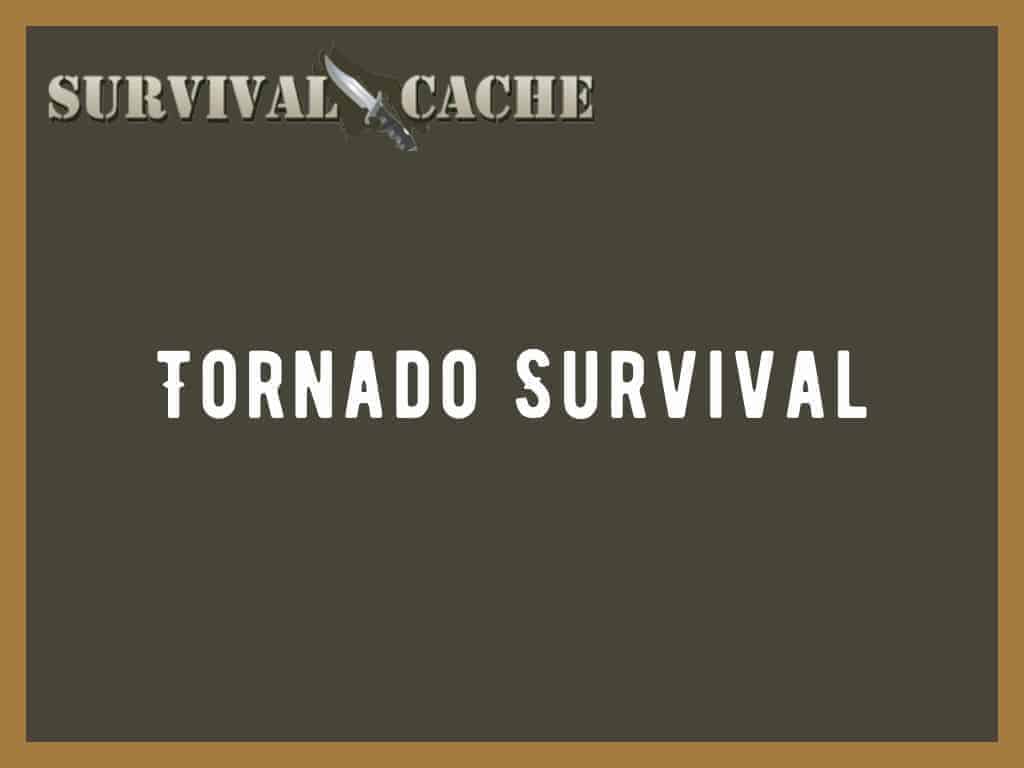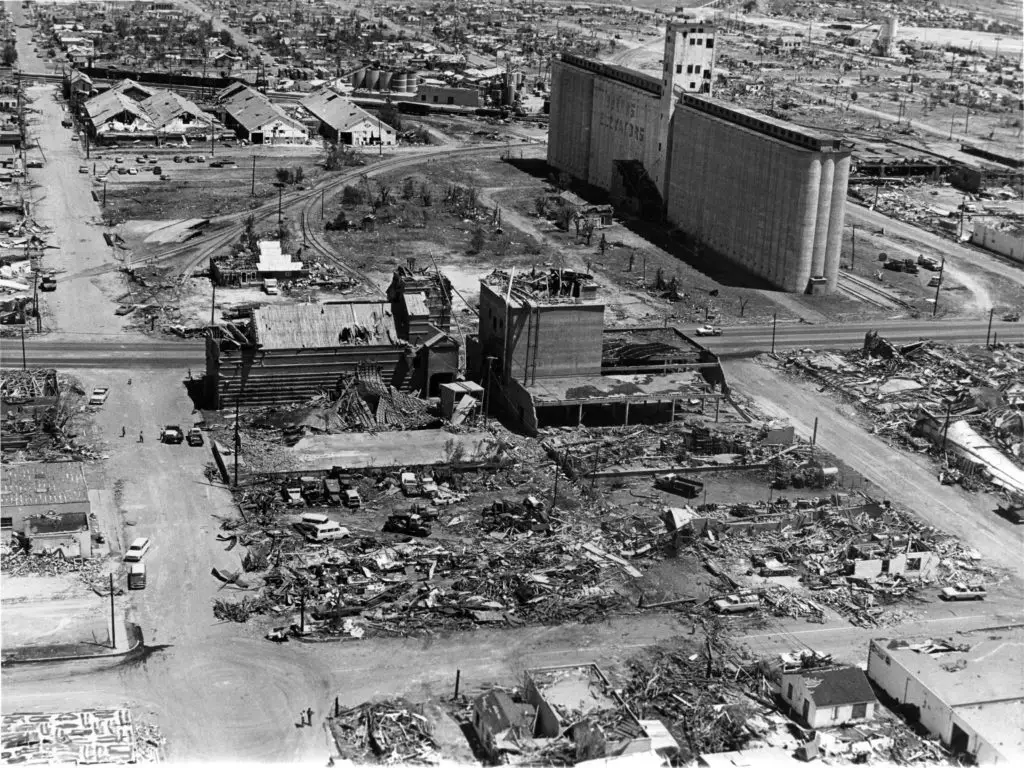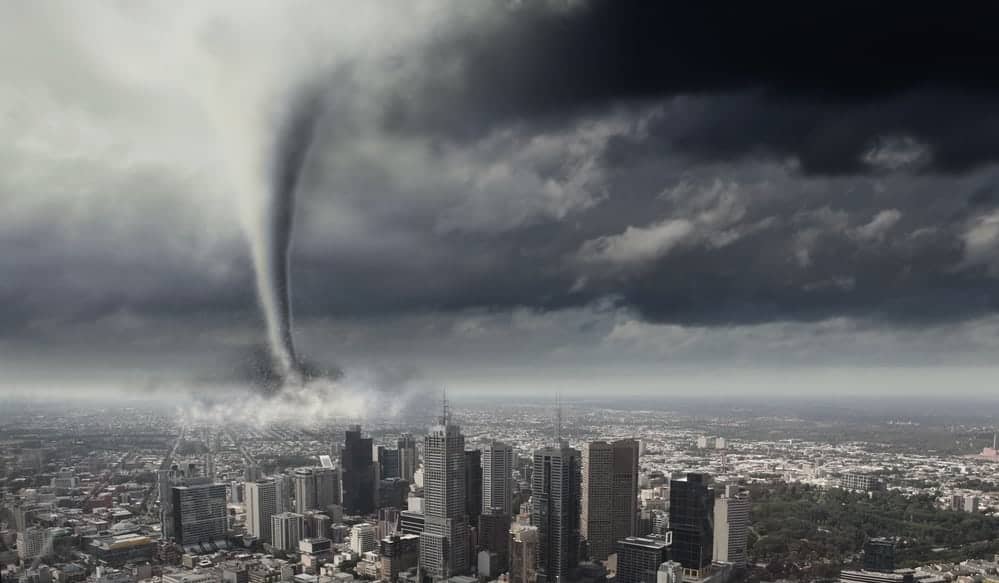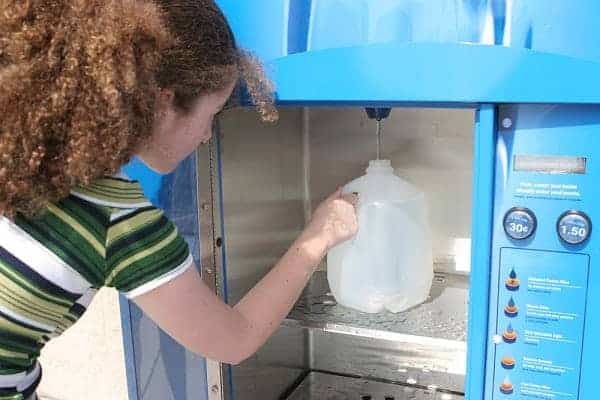I have lived all of my life in what is often called “tornado alley.” A corridor that stretches from the panhandle plains of West Texas northward through Oklahoma, Kansas, and Nebraska. More tornados are documented in this area every year than anywhere else in the world.

It is just a fact of life that every year, if you live in this area, you expect to have tornados at some time. Tornados happen in other places less frequently but with no less devastating results. These weather furies can form fast, strike fast, and disappear just as fast. Knowing how to survive a tornado is a survival skill of which everyone should have some understanding.
Experience has taught me that being prepared is more than half the battle when surviving a tornado. A bit of planning and forethought, some understanding of the kinds of forces that you may face, and basic knowledge of how to protect yourself and your family are the best tools in your survival arsenal.
SKIP AHEAD
May 11, 1970

On May 11, 1970, my home town of Lubbock, Texas, became a major chapter in most of the textbooks and history books that cover weather and tornadoes. The day had been hot and humid but mostly a typical West Texas May day. At 9:35 PM that evening, an F5 tornado touched down just west of the downtown area and began a rampage through the core of the city moving eastward until turning slightly north and cutting through several residential neighborhoods.
The tornado’s path devastated a swath of Lubbock two miles wide at times and, in total, affected a 25 square mile area compromising the main business core, downtown area, and several residential neighborhoods. Directly in the path of the tornado were the Central Fire Station, Main police station, City Hall, and County Courthouse. The city hall which housed the cities emergency operations center took a direct hit.
Becoming a Target
Family circumstances brought me to what was to become the epicenter of the destruction of that tornado. I was 16 years old at the time, working at a local discount grocery store, and not too concerned with the weather. MY grandmother happened to be one of the senior PBX operators for the city. At that time, many complex phone systems were still based on the old plug and relay system of telephone communications.
At about 4 PM in the afternoon, the city activated its Emergency Operations Center because of the forecasted potential for severe weather in the area. As part of the emergency operations plan, my grandmother was required to report to city hall. My mother, my two brothers, and I accompanied my grandmother. The Emergency Operations Center was located in the basement of city hall, and that is where we were when the Tornado ripped through downtown Lubbock.
The Aftermath
The actual event of the tornado strike only lasted a few minutes. I can remember the noise, the feeling, and the incredible power that we all felt. The aftermath is still being dealt with as some of the scars from that event are still visible. It left a lot of indelible scars on people as well.
I witnessed the incredible damage to both properties and to people. I was immediately drafted into service as a runner carrying handwritten messages from the Emergency Operations Center to the Chief of Police and the Fire Chief, who were both operating their organizations from small portable radios because there was not other communications infrastructure operating.
I saw the makeshift emergency medical facilities hastily Cobbled together in a parking lot as dozens of injured people came streaming toward the only place that seemed to have lights and services. The entire hours after the tornado strike still seem a bit surreal. The effects it had on a carefree 16-year-old were immense. Nine years later, I took my oath as a City of Lubbock Fire Fighter. The experiences I had that night were a big part of that decision.
Tornado Survival: How to Prepare

There are some key elements to surviving a tornado. Understanding how those key elements work together to keep you and your family safe will help you prepare. Those key elements are.
- Don’t be there if you can avoid it. – You would be surprised how many people are injured or killed by tornado because they didn’t take the opportunity to not be where the tornado was coming. Tornados can form rapidly and strike with little warning. However, weather forecasting has come a long way in 50 years and most people have a warning of the possibility of severe weather in their area. Don’t chase storms. That is a job for those who are trained and properly equipped.
- Stay informed – Stay abreast of the situation. If there is severe weather in your area, pay attention. Media sources such as broadcast TV and radio are probably your best sources of current information.
- Be Prepared – Have a plan for you and your family. Know where to go and what to do in the event a tornado is imminent. If you are caught away from home, know the best options for protection and use them.
Stay Alert
Situational awareness is a cardinal point in the preparedness world. It is no less applicable to surviving a tornado. In today’s age of high speed and easy to access information, there is no reason that anyone should be caught unawares by severe weather. There is a number of ways to enhance your situational awareness of severe weather.
Local Broadcasters – Local TV and radio are still probably the best means of getting the most up to date and current information about the weather situation in your vicinity. Licensed broadcasters are required by law to provide such information, and most do their level best to serve their communities. Tune in when the weather turns bad and heed the advice you are given.
NOAA Broadcasts – The local weather service in your area broadcasts continuous weather information. This information is transmitted on amateur radio bands that can be received by low-cost handheld receivers. The small walky-talky style radios are available at most outdoor stores and the big box retailers. Look for a radio that specifically mentions the NOAA frequencies.
Weather alert radios – These small radios can be lifesavers. Tuned to the NOAA frequencies, weather alert radios only receive the broadcasts from the weather service. They add one additional function that is crucial. In the event that your area served by the weather service office is threatened by a tornado, the weather service office can cause the radio to sound an earsplitting alarm and then begin to receive the emergency alert. This is a valuable tool that can rouse you from a sound sleep in time to get your family to a safe refuge before a tornado strikes.
Skywarn – Many areas that are prone to tornados are served by Skywarn organizations. These are volunteers who work with the weather service to give first-hand observations of weather conditions. They are highly trained and use amateur radio equipment to provide real-time eyes-on reports of what is actually happening in the atmosphere and on the ground. They are often the first to spot a tornado. You can listen to the reports that these Skywarn organizations give to the local weather service by purchasing a scanner that will operate don the frequencies in use.
Don’t depend on just one means of receiving current information. Sometimes even the best communications will let you down. Be alert and aware of what is happening in your immediate area. Take responsibility for your safety and the safety of your family.
Preparing at Home
Doing a little advance planning at home can make your chances of surviving a tornado much greater. The single biggest factor that affects survivability in a home is the location you choose for shelter. The best places to shelter in a home are:
- Below ground in a basement or specially built shelter.
- An above-ground shelter specifically built to withstand tornados.
- An interior bathroom with no windows and multiple walls or partitions between the bathroom and any outside walls.
- An interior room with no windows
Find a Safe Place
There are two big dangers that cause most of the injuries and deaths that accompany tornados. Building collapse and flying debris are the two scenarios you want to avoid. Finding a place in your home that provides protection from both can be a challenge.
- Below Ground – Below ground level in a space that is reinforced is the best possible option. Below grade level protects you from flying debris and, if the space is properly built, will protect you from building collapse. A purpose-built storm shelter or an area in a basement with reinforcing overhead are both excellent options.
- Above grade shelters – Many new homes in our area are being built with “safe rooms.” These are closets or similar storage spaces that are designed and built to withstand the forces of a tornado and protect the interior from flying debris. These protections can be retrofitted to many homes.
- Interior rooms – Interior rooms in your home, particularly bathrooms, can provide limited protection from collapse and debris. The room should have no windows and as many other walls between the space and the exterior of the home as possible. Bathrooms are good, especially those equipped with cast iron bathtubs because the spaces tend to be more heavily built than other spaces and cast iron bathtubs can provide some protection.
A Word of Caution
Mobile homes are not safe havens during severe weather. If you live in a mobile home in an area where tornadoes or other high wind severe weather is common, you should find a safer place to be during severe weather events. Many communities offer central shelter locations. Take advantage of them.
Have a Plan

Along with having your shelter location planned, you should carry your planning a bit further. Everyone in your family should be familiar with the location you have planned as your shelter. You should drill on getting everyone together and located in the shelter. Practice in the dark as if the lights were not working.
Everyone in your family should be outfitted with a three-day kit or a bug-out bag. There are many good resources on the internet about building these kits. There are some things that are important enough to mention.
- Important Papers – Keep a copy of your important papers with your three-day kit. This should include
- Insurance policies – particularly your homeowner’s policies
- Birth Certificates and Personal Identification
- Deeds to your home
- Personal Identification for everyone in your household
- Extra Cash – Include some extra cash in your bags. You never know what you may need.
- Extra Clothing
No one ever wants to be displaced, but all too often, the aftermath of a tornado strike results in families being without a home and many of their personal belongings for weeks, if not months at a time. Planning ahead for these eventualities at least mitigate some of the emotional trauma that these kinds of losses can deliver.
On the Road When A Tornado Hits: What To Do?

Being caught traveling during severe weather is not as uncommon as you might think. Cross country trips are even a short afternoon drive can put you are risk of encountering severe weather in places you might least expect. Knowing how to handle the dangers of a tornado when traveling is as important as making your home plan.
The Do’s
There are some things that you should do if you find yourself threatened by an encounter with a tornado while on a trip.
- Find Shelter – If there is a building, almost any building, it is better than trying to ride out a tornado in your automobile. Fast food restaurants are a good choice. Walk-in coolers make good emergency shelters as do the interior bathrooms of such establishments.
- Drive away – Find a route that takes you 90 degrees to the path of the tornado. This will put the most distance between you and the tornado as possible in the shortest amount of time.
- Abandon the Car – If you can’t get away from the tornado, the car is the last place you want to be. Abandon the car and find someplace like a ditch, culvert, or other depression. This will help protect you from the wind and the flying debris. Your care, more than likely, is going to become a flying object and you don’t want to be inside when it lands.
The Don’ts
Knowing what not to do if you are caught in the open in a car by a rapidly advancing tornado is as important as knowing what to do.
- Highway Underpasses – Don’t stop and crawl up the underside of a highway underpass thining that is a good place to shelter. The underside of the underpass can actually increase the speed of the wind during a tornado and funnel flying debris right into the area you are using as a shelter.
- Outrunning a Tornado – This is never a good idea. Not only does it put you at increased risk for an automobile accident, but the speed that an advancing tornado can make is also surprising. High speeds during weather events involve wet roads, strong gusty winds, and perhaps even ice on the road due to hail. Turn and head 90 degrees to the path of the tornado and drive carefully.
- Ride it out in your car – Even the biggest vehicles are no match of the kinds of winds that a tornado can produce. A vehicle tossed about by a tornado is no safe haven. The safety glass in car windows is no match for the debris and tumbling around inside a vehicle blown about by a tornado is certainly not a ride you want to take.
Don’t Be Caught Unprepared
The real secret to surviving a tornado is to stay aware. Very rarely do tornados strike without at least a small warning period. Weather forecasting now provides hours of notification when there is the possibility of severe weather occurring in a given area. Heed a tornado watch is issued and raise your awareness level.
When a tornado watch is elevated to a tornado warning, the threat to the area is imminent, and you should act accordingly. Gather your family and get to your safe place. Take your weather radio and stay aware of the situation. Don’t take chances. Any survival situation requires vigilance, planning, and execution. Surviving a tornado is no exception. Be vigilant. Have a plan. Execute that plan when the time comes.

